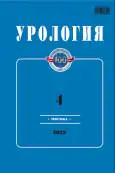Logical and molecular «portrait» hybrid renal tumors
- Authors: Osmanov Y.I.1, Kogan E.A.1, Gadzhieva Z.K.2, Protsenko D.D.1
-
Affiliations:
- Institute of Clinical Morphology and Digital Pathology of the Federal State Autonomous Educational Institution of Higher Education I.M. Sechenov First Moscow State Medical University of the Ministry of Health of the Russian Federation (Sechenov University)
- Department for the Analysis of Personnel Policy, Educational Programs and Scientific Research of the National Medical Research Center on the profile «Urology» of the Federal State Autonomous Educational Institution of Higher Education I.M. Sechenov First Moscow State Medical University of the Ministry of Health of the Russian Federation (Sechenov University)
- Issue: No 4 (2023)
- Pages: 113-116
- Section: Oncourology
- Published: 21.09.2023
- URL: https://journals.eco-vector.com/1728-2985/article/view/587637
- DOI: https://doi.org/10.18565/urology.2023.4.113-116
- ID: 587637
Cite item
Abstract
A hybrid tumor is not officially included in the latest International Histological Classification of Kidney Tumors (WHO, 2022), however, according to the literature, a number of researchers still consider a hybrid tumor as an independent nosological unit. In this regard, the development of morphological and molecular genetic criteria for a hybrid tumor, today, is the main task in the differential diagnosis of oncocytic renal tumors.
Aim. Our aim was to carry out to identify immunohistochemical, ultrastructural features and determine the molecular profile of hybrid renal tumors.
Patients and methods. The study was performed on the surgical material of 12 patients with a hybrid tumor of the kidney. Immunohistochemical study was carried out on paraffin sections according to the standard protocol. Antibodies CK7, CD117, Cyclin D1, EpCAM, Caveolin1, EABA, and S100A1 were used. To study tumor tissues on semi-thin and ultra-thin sections, an electron microscope Philips TECNAI 12 BioTwinD-265 is used. For in situ fluorescent diagnostic detection, defined centromere probes, LSI 13/21, LSI N25 /LSI ARSA and TelVysion telomeric probe.
Results. In some cases, a hybrid tumor is represented by a solid structure of monomorphic oxyphilic cells with a characteristic immuno-, ultraphenotype and molecular profile.
Conclusion. The results of a comprehensive study confirm that the hybrid tumor is an intermediate link in the process of malignant transformation of oncocytoma into chromophobe renal cell carcinoma.
Full Text
About the authors
Y. I. Osmanov
Institute of Clinical Morphology and Digital Pathology of the Federal State Autonomous Educational Institution of Higher Education I.M. Sechenov First Moscow State Medical University of the Ministry of Health of the Russian Federation (Sechenov University)
Author for correspondence.
Email: osmanovyouseef@yandex.ru
ORCID iD: 0000-0002-7269-4190
MD, professor of Institute of Clinical Morphology and Digital Pathology of I.M. Sechenov First Moscow State Medical University
Russian Federation, MoscowE. A. Kogan
Institute of Clinical Morphology and Digital Pathology of the Federal State Autonomous Educational Institution of Higher Education I.M. Sechenov First Moscow State Medical University of the Ministry of Health of the Russian Federation (Sechenov University)
Email: koganevg@gmail.com
ORCID iD: 0000-0002-1107-3753
MD, professor, Institute of Clinical Morphology and Digital Pathology of I.M. Sechenov First Moscow State Medical University
Russian Federation, MoscowZ. K. Gadzhieva
Department for the Analysis of Personnel Policy, Educational Programs and Scientific Research of the National Medical Research Center on the profile «Urology» of the Federal State Autonomous Educational Institution of Higher Education I.M. Sechenov First Moscow State Medical University of the Ministry of Health of the Russian Federation (Sechenov University)
Email: zgadzhieva@ooorou.ru
MD, professor of Department of Urology of Sechenov First Moscow State Medical University (Sechenov University)
Russian Federation, MoscowD. D. Protsenko
Institute of Clinical Morphology and Digital Pathology of the Federal State Autonomous Educational Institution of Higher Education I.M. Sechenov First Moscow State Medical University of the Ministry of Health of the Russian Federation (Sechenov University)
Email: chief@medprint.ru
ORCID iD: 0000-0002-5851-2768
Ph.D., assistant professor of Institute of Clinical Morphology and Digital Pathology of I.M. Sechenov First Moscow State Medical University
Russian Federation, MoscowReferences
- Pavlovich C., Walther M, Eyler R. et al. Renal tumors in the Birt-Hogg-Dubé syndrome. A.m J Surg Pathol. 2002;26(12):1542–1552. doi: 10.1097/00000478-200212000-00002.
- Gawlik-jakubczak T., Matuszewski M.. Hybrid Oncocitic/Chromophobe Renal Cell Carcinoma. J Clin Case Rep. 2018;8(10):1186. doi: 10.4172/2165-7920.10001186.
- Cimadamore A., Cheng L., Scarpelli M., et al. Towards a new WHO classification of renal cell tumor: what the clinician needs to know-a narrative review. Transl Androl Urol. 2021 Mar; 10(3): 1506–1520. doi: 10.21037/tau-20-1150.
- Lobo J., Ohashi R., Amin M.B. et al. WHO 2022 landscape of papillary and chromophobe renal cell carcinoma. Histopathology. 2022 May 21. https://doi.org/10.1111/his.14700
- Cossu-Rocca P., Eble J.N., Zhang S. et al. Acquired cystic disease-associated renal tumors: an immunohistochemical and fluorescence in situ hybridization study. J Modern Pathology. 2006;19:780–787. Doi.org/10.1038/modpathol.3800604.
- Wu A. Oncocytic Renal Neoplasms on Resections and Core Biopsies. Arch Pathol Lab Med. 2017;141:1336–1341. doi: 10.5858/arpa.2017-0240-RA.
- Poté N., Vieillefond A., Couturier J. et al. Hybrid oncocytic/chromophobe renal cell tumours do not display genomic features of chromophobe renal cell carcinomas. Virchows Arch. 2013;462(6):633–638. doi: 10.1007/s00428-013-1422-4.
- Liu Y., Ussakli C., Antic T. et al. Sporadic oncocytic tumors with features intermediate between oncocytoma and chromophobe renal cell carcinoma: comprehensive clinicopathological and genomic profiling. Hum Pathol. 2020;104:18–29. doi: 10.1016/j.humpath.2020.07.003.
- Petersson F., Gatalica Z., Grossmann P. et al. Sporadic hybrid oncocytic/chromophobe tumor of the kidney: a clinicopathologic, histomorphologic, immunohistochemical, ultrastructural, and molecular cytogenetic study of 14 cases. Virchows Arch. 2010;456(4):355–365. doi: 10.1007/s00428-010-0898-4.
- Joshi S., Tolkunov D., Aviv H. et al. The Genomic Landscape of Renal Oncocytoma Identifies a Metabolic Barrier to Tumorigenesis. Cell Rep. 2015;13(9):1895–1908. doi: 10.1016/j.celrep.2015.10.059.
Supplementary files











